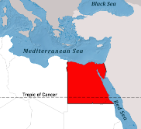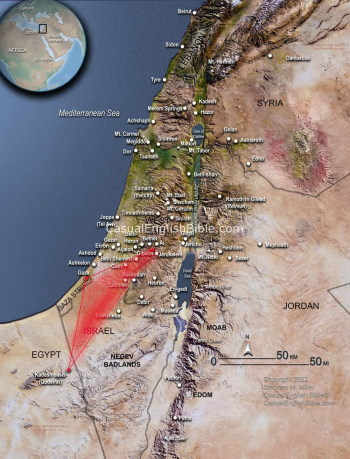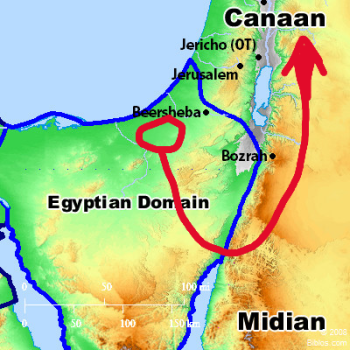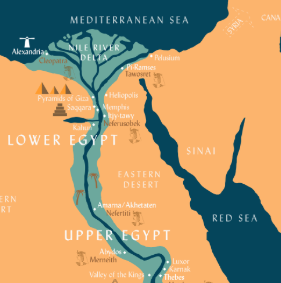There's a problem with our Bible translations. It's about Egypt. Egypt figures prominently in the Exodus story, but the word Egypt is a translation and maybe not a very good one. The problem is that saying Egypt conjures images of modern Egypt...

...or the historical Egyptian empire...

...and neither of those are exactly what the Bible means by Mizraim.
In the Bible, Mizraim, is the descendants of the man named Mizraim. That does include Egypt, but it also includes other places - all of Libya, the island of Crete, and the southern half of Israel. The Philistines on Israel's coast are part of Mizraim:
Genesis 10: Mizraim begat Ludim, and Anamim, and Lehabim, and Naphtuhim, And Pathrusim, and Casluhim, (out of whom came Philistim,) and Caphtorim.
This raises a question of where exactly the Israelites captivity was located. Archaeologists have been calling into question the traditional Exodus route for decades now, saying that there is no evidence they've dug up showing that 2 million Israelites died in the deserts of Sinai.
Fortunately, the Bible gives us two other pieces of information. It tells us that the Israelites and their flocks were in the land of Goshen, and it tells us that the Israelites began their trek out of Egypt from Rameses.
Rameses turns out to be a little tricky. There is a city in Egypt named Pi-Rameses in the lower delta of the Nile. Many Exodus maps show it as the location from which the Israelites set out. But Pi-Rameses means "household of Rameses," and thus Rameses turns out to be a mobile city. Wherever Pharoah traveled, the mobile city that supported him traveled. Rameses could be located almost anywhere in Egypt proper, or within any of the Pharoah's vassal territories.
So let's look at Goshen. The Bible actually gives us enough information to locate it:
Joshua 10:41 Joshua smote them from Kadeshbarnea even unto Gaza, and all the country of Goshen, even unto Gibeon.
Those three locations make a triangle like this:

This means that Goshen, where the Israelites were in captivity, was actually within the borders of modern Israel. From here the path of the Exodus becomes clearer. We know that they had to travel around Edom, because the Edomites would not grant them safe passage, we know that they passed Teman, and we know that they ended up East of Jordan and subsequently invaded the Amorite lands in Bashan and Gilead. This makes the likely Exodus path look like this:


...or the historical Egyptian empire...
...and neither of those are exactly what the Bible means by Mizraim.
In the Bible, Mizraim, is the descendants of the man named Mizraim. That does include Egypt, but it also includes other places - all of Libya, the island of Crete, and the southern half of Israel. The Philistines on Israel's coast are part of Mizraim:
Genesis 10: Mizraim begat Ludim, and Anamim, and Lehabim, and Naphtuhim, And Pathrusim, and Casluhim, (out of whom came Philistim,) and Caphtorim.
This raises a question of where exactly the Israelites captivity was located. Archaeologists have been calling into question the traditional Exodus route for decades now, saying that there is no evidence they've dug up showing that 2 million Israelites died in the deserts of Sinai.
Fortunately, the Bible gives us two other pieces of information. It tells us that the Israelites and their flocks were in the land of Goshen, and it tells us that the Israelites began their trek out of Egypt from Rameses.
Rameses turns out to be a little tricky. There is a city in Egypt named Pi-Rameses in the lower delta of the Nile. Many Exodus maps show it as the location from which the Israelites set out. But Pi-Rameses means "household of Rameses," and thus Rameses turns out to be a mobile city. Wherever Pharoah traveled, the mobile city that supported him traveled. Rameses could be located almost anywhere in Egypt proper, or within any of the Pharoah's vassal territories.
So let's look at Goshen. The Bible actually gives us enough information to locate it:
Joshua 10:41 Joshua smote them from Kadeshbarnea even unto Gaza, and all the country of Goshen, even unto Gibeon.
Those three locations make a triangle like this:

This means that Goshen, where the Israelites were in captivity, was actually within the borders of modern Israel. From here the path of the Exodus becomes clearer. We know that they had to travel around Edom, because the Edomites would not grant them safe passage, we know that they passed Teman, and we know that they ended up East of Jordan and subsequently invaded the Amorite lands in Bashan and Gilead. This makes the likely Exodus path look like this:



